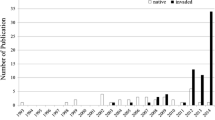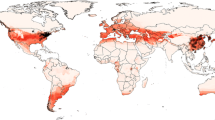Abstract
The invasive mealybug Maconellicoccus hirsutus (Green) (Hemiptera: Pseudococcidae) is a plant feeding insect believed to be native to Southern Asia or Australia. This mealybug has become established in many regions throughout the world (including the Caribbean and North America) in the past 100 years and is currently expanding its range in South America. Because this insect is of concern as a potential pest of many plant species, this review is provided to summarize knowledge of M. hirsutus based on past research that may be most useful for addressing the current invasion of South America by the species, and to identify gaps in information that may need to be addressed to inhibit the spread of the insect and improve management methods for this and similar organisms. In most areas into which M. hirsutus has expanded its range it is commonly suppressed by native or introduced natural enemies. Therefore, besides preventing introduction, establishment and spread of this potential pest, efforts should be made to determine if natural enemies of M. hirsutus are present in areas of concern (i.e., where the mealybug may be introduced and become established). Such information will enable determination of the need for introduction or augmentation of biological control agents in response to possible entry and establishment of the mealybug in new areas. Methods developed in response to the recent invasion of the Caribbean and North America by M. hirsutus may serve as models for addressing the threat of this and similar invasive pests in South America and elsewhere.



Similar content being viewed by others
References
Abd-Rabou S (2008) Updated list of the parasitoids attacking mealybugs (Hemiptera: Pseudococcidae) in Egypt. In: Branco M, Franco JC, Hodgson CJ (eds) Proceedings of the XI international symposium on scale insect studies, Oeiras, Portugal, September 2007. ISA Press, Lisbon, pp 235–240
Abd-Rabou S, Shalaby H, Germain JF, Ris N, Kreiter P, Malausa T (2012) Identification of mealybug pest species (Hemiptera: Pseudococcidae) in Egypt and France, using a DNA barcoding approach. Bull Entomol Res 24:1–9
Aristizábal LF, Mannion C, Bergh C, Arthurs S (2012) Life history of pink hibiscus mealybug, Maconellicoccus hirsutus (Hemiptera: Pseudococcidae) on three Hibiscus rosa-sinensis cultivars. Fla Entomol 90:440–446
Ben-Dov Y, Miller DR, Gibson GAP (2012) ScaleNet. http://www.sel.barc.usda.gov/scalenet/scalenet.htm. Accessed 14 Sept 2012
Bento JMS, de Moraes GJ, de Matos AP, Bellotti AC (2000) Classical biological control of the mealybug Phenacoccus herreni (Hemiptera: Pseudococcidae) in northeastern Brazil. Environ Entomol 29:355–359
CABI/EPPO (2004) Maconellicoccus hirsutus. Distribution maps of plant pests No. 100. CAB International, Wallingford
Castle SJ, Prabhaker N (2011) Field evaluation of two systemic neonicotinoid insecticides against pink hibiscus mealybug (Maconellicoccus hirsutus (Green)) on mulberry trees. J Pest Sci 84:363–371
Cermeli M, Valles PM, Godoy F, Romero R, Cárdenas O (2002) Presencia de la cochinilla rosada de la cayena Maconellicoccus hirsutus (Green) (Hemiptera: Pseudococcidae) en Venezuela. Entomotropica 17(1):103–105
Chong JH (2009) First report of the pink hibiscus mealybug, Maconellicoccus hirsutus (Green) (Hemiptera: Pseudococcidae), in South Carolina. J Agric Urban Entomol 26):87–94
Chong JH, Roda AL, Mannion CM (2008) Life history of the mealybug, Maconellicoccus hirsutus (Hemiptera: Pseudococcidae), at constant temperatures. Environ Entomol 37(2):323–332
Culik MP, Martins D dos S, Ventura JA (2011) New distribution and host records of chalcidoid parasitoids (Hymenoptera: Chalcidoidea) of scale insects (Hemiptera: Coccoidea) in Espírito Santo, Brazil. Biocontrol Sci Tech 21:877–881
Daane KM, Almeida RPP, Bell VA, Walker JTS, Botton M, Fallahzadeh M, Mani M, Miano JL, Sforza R, Walton VM, Zaviezo T (2012) Biology and management of mealybugs in vineyards. In: Bostanian NJ, Vincent C, Isaacs R (eds) Arthropod management in vineyards: pests, approaches, and future directions. Springer, Dordrecht, pp 271–307
De Lotto G (1954) Three apparently new mealy bugs from Kenya. Proc R Entomol Soc Lond 23:110–114
FAO (2011) Pest risk analysis for quarantine pests including analysis of environmental risks and living modified organisms. https://www.ippc.int/file_uploaded/1323945243_ISPM_11_2004_En_2011-11-29_Refor.pdf. Accessed 14 Mar 2013
Francis A, Bloem KA, Roda AL, Lapointe SL, Zhang A, Onokpise O (2007) Development of trapping methods with a synthetic sex pheromone of the pink hibiscus mealybug, Maconellicoccus hirsutus (Hemiptera: Pseudococcidae). Fla Entomol 90:440–446
Gajadin N (2004) Control of the hibiscus mealy bug (Maconellicoccus hirsutus) in Suriname: a comparative study of the chemical and biological control. BSc Thesis, Anton de Kom University of Suriname
García-Valente F, Ortega-Arenas LD, González-Hernández H, Villanueva-Jiménez JA, López-Collado J, González-Hernández A, Arredondo-Bernal HC (2009) Parasitismo natural e inducido de A. kamali sobre la cochinilla rosada en brotes de teca, en Bahía de Banderas, Nayarit. Agrociencia 43:729–738
González FG (2012) Coccinellidae de Brasil. http://www.coccinellidae.cl/paginasWebBra/Paginas/Cryptolaemus_montrouzieri_Bra.php. Accessed 11 Mar 2013
González-Gaona E, Sánchez-Martínez G, Zhang A, Lozano-Gutiérrez J, Carmona-Sosa F (2010) Validación de dos compuestos feromonales para el monitoreo de la cochinilla rosada del hibisco en México. Agrociencia 44:65–73
Goolsby JA, Kirk AA, Meyerdirk DE (2002) Seasonal phenology and natural enemies of Maconellicoccus hirsutus (Hemiptera: Pseudococcidae) in Australia. Fla Entomol 85(3):494–498
Hall DG, Roda A, Lapointe SL, Hibbard K (2008) Phenology of Maconellicoccus hirsutus (Hemiptera: Pseudococcidae) in Florida based on attraction of adult males to pheromone traps. Fla Entomol 91:305–310
Hara AH, Jacobsen CM (2005) Hot water immersion for surface disinfestations of Maconellicoccus hirsutus (Homoptera: Pseudococcidae). J Econ Entomol 98:284–288
IPPC (2013) Latin America & Caribbean. https://www.ippc.int/index.php?id=37229&L=0. Accessed 13 Mar 2013
Jara V, Meza FJ, Zaviezo T, Chorbadjian R (2012) Climate change impacts on invasive potential of pink hibiscus mealybug, Maconellicoccus hirsutus (Green), in Chile. Climatic Change. http://www.springerlink.com/content/t3x267137254861v/fulltext.pdf?MUD=MP. Accessed 9 Nov 2012
Kairo MTK, Pollard GV, Peterkin DD, Lopez VF (2000) Biological control of the hibiscus mealybug, Maconellicoccus hirsutus Green (Hemiptera: Pseudococcidae) in the Caribbean. Integr Pest Manag Rev 5(4):241–254
Katke M (2008) Seasonal incidence, biology and management of grape mealy bug, Maconellicoccus hirsutus (Green)(Homoptera: Pseudococcidae). Masters Thesis, University of Agricultural Sciences, Dharwad 89 pp
Kondo T, Ramos-Portilla AA, Vergara-Navarro EV (2008) Updated list of mealybugs and putoids from Colombia (Hemiptera: Pseudococcidae and Putoidae). Boletin del Museo de Entomologia de la Universidad del Valle 9(1):29–53
Krishnamoorthy A, Mani M (1989) Records of green lacewings preying on mealybugs in India. Curr Sci 58(3):155–156
Machado da Costa J, Williams RN, Schuster MF (1970) Rhodesgrass scale, Antonina graminis, in Brazil. II. Introduction of Neodumetia sangwani, natural enemy of rhodesgrass scale. Pesq Agropec Bras 5:15–24
Malausa T, Fenis A, Warot S, Germain J-F, Ris N, Prado E, Botton M, Vanlerberghe-Masutti F, Sforza R, Cruaud C, Couloux A, Kreiter P (2011) DNA markers to disentangle complexes of cryptic taxa in mealybugs (Hemiptera: Pseudococcidae). J Appl Entomol 135:142–155
Marsaro AL Jr., Peronti ALBG, Penteado-Dias AM, Morais EGF, Pereira PRVS (2013) First report of Maconellicoccus hirsutus (Green, 1908) (Hemiptera: Coccoidea: Pseudococcidae) and the associated parasitoid Anagyrus kamali Moursi, 1948 (Hymenoptera: Encyrtidae), in Brazil. Braz J Biol 73 (in press)
Matile-Ferrero D, Étienne J, Tiego G (2000) Introduction de deux ravageurs d’importance pour la Guyane française: Maconellicoccus hirsutus et Paracoccus marginatus (Hem., Coccoidea, Pseudococcidae). Bulletin de la Société Entomologique de France 105(5):485–486
Meyerdirk DE, Warkentin R, Attavian B, Gersabeck E, Francis A, Adams J, Francis G (2001) Biological control of pink hibiscus mealybug project manual. USDA, Washington. http://www.aphis.usda.gov/import_export/plants/manuals/domestic/downloads/phm.pdf. Accessed 14 Sep 2012
Michaud JP (2003) Three targets of classical biological control in the Caribbean: success, contribution, and failure. In: Van Dreische RG (ed) Proceedings of the first international symposium on biological control of arthropods. FHTET-03-05. USDA Forest Service Washington, pp 335–342
Michaud JP, Evans GA (2000) Current status of pink hibiscus mealybug in Puerto Rico including a key to parasitoid species. Fla Entomol 83(1):97–101
Millennium Ecosystem Assessment (2005) Ecosystems and human well-being: current state and trends. Island Press, Washington
Miller DR (1999) Identification of the pink hibiscus mealybug, Maconellicoccus hirsutus (Green) (Hemiptera: Sternorrhyncha: Pseudococcidae). Insecta Mundi 13(3/4):189–202
Ministério da Agricultura (2011) Roraima tem saída de mudas de vegetais proibida. http://www.agricultura.gov.br/vegetal/noticias/2011/08/roraima-tem-saida-de-mudas-de-vegetais-proibida. Accessed 13 Mar 2013
Ministério da Agricultura (2013) Fitossanitárias. http://www.agricultura.gov.br/internacional/negociacoes/multilaterais/fitossanitarias. Accessed 13 Mar 2013
Nalini T, Manickavasagam S (2011) Records of Encyrtidae (Hymenoptera: Chalcidoidea) parasitoids on mealybugs (Hemiptera: Pseudococcidae) from Tamil Nadu. India Check List 7:510–515
Noyes JS (2012) Universal Chalcidoidea Database. World Wide Web electronic publication. http://www.nhm.ac.uk/chalcidoids Accessed 14 Sep 2012
OEPP/EPPO (2005) Data sheets on quarantine pests Maconellicoccus hirsutus. Bull OEPP/EPPO Bull 35:413-415
OEPP/EPPO (2006) Diagnostics Maconellicoccus hirsutus. Bull OEPP/EPPO Bull 36:167–169
OIRSA (2012) Programa de control biológico de la cochinilla rosada. OIRSA (Organismo Internacional Regional de Sanidad Agropecuaria. http://www.oirsa.org/portal/CochinillaRosada.aspx. Accessed 5 Nov 2012
Parra JRP, de Oliveira HN, de PintoA S (2003) Guia ilustrado de pragas e insetos benéficos dos citros. A de S Pinto, Piracicaba
Radosevich S (2007) Plant invasions and their management. In: CIPM (ed) Invasive plant management: CIPM online textbook. Center for Invasive Plant Management, Bozeman. http://www.weedcenter.org/textbook/3_rados_invasion.html. Accessed 14 Mar 2013
Ramos PEE, Hernández HG (2010) Plan de contingencia ante un brote de cochinilla rosada del hibisco (Maconellicoccus hirsutus) en un país de la región del OIRSA. OIRSA, San Salvador
Reddy GVP, Muniappan R, Cruz ZT, Naz F, Bamba JP, Tenorio J (2009) Present status of Maconellicoccus hirsutus (Hemiptera: Pseudococcidae) in the Mariana Islands and its control by two fortuitously introduced natural enemies. J Econ Entomol 102(4):1431–1439
Roltsch WJ, Meyerdirk DE, Warkentin R, Andress ER, Carrera K (2006) Classical biological control of the pink hibiscus mealybug, Maconellicoccus hirsutus (Green), in southern California. Biol Control 37(2):155–166
Rung A, Venable GL, Miller DR, Gill RJ, Williams DJ (2007) Scale insects: identification tools for species of quarantine importance. Scale Families. USDA, Washington. http://www.sel.barc.usda.gov/ScaleKeys/Mealybugs/Key/Mealybugs/Media/html/AboutFset.html. Accessed 14 Sep 2012
Sagarra LA, Peterkin DD (1999) Invasion of the Caribbean by the hibiscus mealybug, Maconellicoccus hirsutus Green (Homoptera: Pseudococcidae). Phytoprotection 80(2):103–113
Sanches NF, Carvalho R da S (2010) Procedimentos para manejo da criação e multiplicação do predador exótico Cryptolaemus montrouzieri, Circular Técnica 99. Embrapa Mandioca e Fruticultura, Cruz das Almas
Sanches NF, Carvalho R da S, Silva ES, Santos IP, Caldas RC (2002) Técnica de criação do predador exótico Cryptolaemus montrouzieri Mulsant (Col.; Coccinellidae) em laboratório, Circular Técnica 47. Embrapa Mandioca e Fruticultura, Cruz das Almas
Schrader G, Unger JG (2003) Plant quarantine as a measure against invasive alien species: the framework of the International Plant Protection Convention and the plant health regulations in the European Union. Biol Invasions 5:357–364
Serrano MS, Lapointe SL (2002) Evaluation of host plants and a meridic diet for rearing Maconellicoccus hirsutus (Hemiptera: Pseudococcidae) and its parasitoid Anagyrus kamali (Hymenoptera : Encyrtidae). Fla Entomol 85(3):417–425
Simberloff D (2009) We can eliminate invasions or live with them. Successful management projects Biol Invasions 11:149–157
SINAVEF (2010) Reporte epidemiológico cochinilla rosada del hibisco. SINAVEF, San Luis Potosí. http://portal.sinavef.gob.mx/documentos/BoletinesVarios/4_2_5RE_CRH001.pdf. Accessed 9 Nov 2012
Singh SP (2004) Some success stories in classical biological control of agricultural pests in India. APAARI Publ 2004/2, Asia-Pacific association of agricultural research institutions, Bangkok
Tambasco FJ, Sá LAN, de Nardo EAB, Tavares MT (2000) Cochonilha rosada, Maconellicoccus hirsutus (Green): uma praga de importancia quarentenaria ja se encontra na guiana inglesa. Floresta 30(1–2):85–93
Venette RC, Carey JR (1998) Invasion biology: rethinking our response to alien species. Calif Agric 52:13–17
Vitullo J, Zhang A, Mannion C, Bergh JC (2009) Expression of feeding symptoms from pink hibiscus mealybug (Hemiptera: Pseudococcidae) by commercially important cultivars of hibiscus. Fla Entomol 92:248–254
Williams DJ (1996) A brief account of the hibiscus mealybug Maconellicoccus hirsutus (Hemiptera: Pseudococcidae), a pest of agriculture and horticulture, with descriptions of two related species from southern Asia. Bull Entomol Res 86:617–628
Acknowledgments
Research support provided by the Fundação de Amparo à Pesquisa do Espírito Santo (FAPES), Fundação de Amparo à Pesquisa do Estado de Minas Gerais (FAPEMIG), Financiadora de Estudos e Projetos (FINEP), and Conselho Nacional de Desenvolvimento Científico e Tecnológico (CNPq). We thank Renato C. Taques, INCAPER, for preparing the map (Fig. 1).
Author information
Authors and Affiliations
Corresponding author
Additional information
Communicated by C. Cutler.
Rights and permissions
About this article
Cite this article
Culik, M.P., Fornazier, M.J., dos Santos Martins, D. et al. The invasive mealybug Maconellicoccus hirsutus: lessons for its current range expansion in South America and invasive pest management in general. J Pest Sci 86, 387–398 (2013). https://doi.org/10.1007/s10340-013-0512-z
Received:
Accepted:
Published:
Issue Date:
DOI: https://doi.org/10.1007/s10340-013-0512-z




